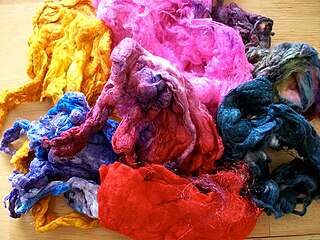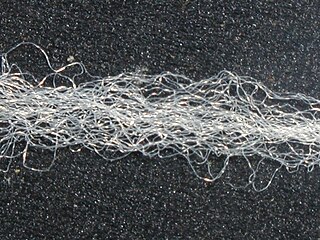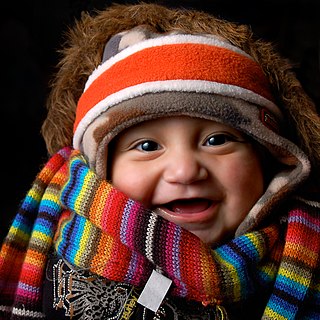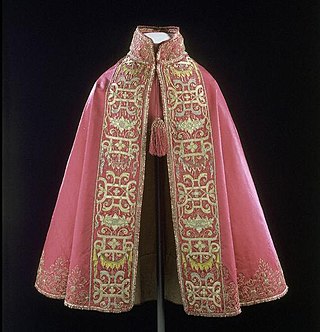Related Research Articles

Textile is an umbrella term that includes various fiber-based materials, including fibers, yarns, filaments, threads, different fabric types, etc. At first, the word "textiles" only referred to woven fabrics. However, weaving is not the only manufacturing method, and many other methods were later developed to form textile structures based on their intended use. Knitting and non-woven are other popular types of fabric manufacturing. In the contemporary world, textiles satisfy the material needs for versatile applications, from simple daily clothing to bulletproof jackets, spacesuits, and doctor's gowns.

Yarn is a long continuous length of interlocked fibres, used in sewing, crocheting, knitting, weaving, embroidery, ropemaking, and the production of textiles. Thread is a type of yarn intended for sewing by hand or machine. Modern manufactured sewing threads may be finished with wax or other lubricants to withstand the stresses involved in sewing. Embroidery threads are yarns specifically designed for needlework. Yarn can be made of a number of natural or synthetic materials, and comes in a variety of colors and thicknesses. Although yarn may be dyed different colours, most yarns are solid coloured with a uniform hue.

Velvet is a type of woven fabric with a dense, even pile that gives it a distinctive soft feel. By extension, the word velvety means "smooth like velvet". Historically, velvet was typically made from silk. Today, velvet can be made from silk, linen, cotton, wool, synthetic fibers, silk-cotton blends, or synthetic-natural fiber blends.

Dyeing is the application of dyes or pigments on textile materials such as fibers, yarns, and fabrics with the goal of achieving color with desired color fastness. Dyeing is normally done in a special solution containing dyes and particular chemical material. Dye molecules are fixed to the fiber by absorption, diffusion, or bonding with temperature and time being key controlling factors. The bond between the dye molecule and fiber may be strong or weak, depending on the dye used. Dyeing and printing are different applications; in printing, color is applied to a localized area with desired patterns. In dyeing, it is applied to the entire textile.

Noil refers to the short fibers that are removed during the combing process in spinning. These fibers are often then used for other purposes.

Textile manufacturing or textile engineering is a major industry. It is largely based on the conversion of fibre into yarn, then yarn into fabric. These are then dyed or printed, fabricated into cloth which is then converted into useful goods such as clothing, household items, upholstery and various industrial products.
The manufacture of textiles is one of the oldest of human technologies. To make textiles, the first requirement is a source of fiber from which a yarn can be made, primarily by spinning. The yarn is processed by knitting or weaving, which turns yarn into cloth. The machine used for weaving is the loom. For decoration, the process of colouring yarn or the finished material is dyeing. For more information of the various steps, see textile manufacturing.
A staple fiber is a textile fiber of discrete length. The opposite is a filament fiber, which comes in continuous lengths. Staple length is a characteristic fiber length of a sample of staple fibers. It is an essential criterion in yarn spinning, and aids in cohesion and twisting. Compared to synthetic fibers, natural fibers tend to have different and shorter lengths. The quality of natural fibers like cotton is categorized into staple length such as short, medium, long staple, and extra-long. Gossypium barbadense, one of several cotton species, produces extra-long staple fibers. The staple fibers may be obtained from natural and synthetic sources. In the case of synthetics and blends, the filament yarns are cut to a predetermined length.

Novelty yarns include a wide variety of yarns made with unusual features, structure or fiber composition such as slubs, inclusions, metallic or synthetic fibers, laddering and varying thickness introduced during production. Some linens, wools to be woven into tweed, and the uneven filaments of some types of silk are allowed to retain their normal irregularities, producing the characteristic uneven surface of the finished fabric. Man-made fibres, which can be modified during production, are especially adaptable for special effects such as crimping and texturizing.

In textile manufacturing, finishing refers to the processes that convert the woven or knitted cloth into a usable material and more specifically to any process performed after dyeing the yarn or fabric to improve the look, performance, or "hand" (feel) of the finish textile or clothing. The precise meaning depends on context.

Texturising or texturizing is the process by which synthetic fibres are modified to change their texture - the physical appearance of the fibre. Texturising techniques can include bulking, crimping and coiling, amongst others. Texturising takes advantage of the thermoplastic nature of synthetic fibres, and uses it to set texturised features in place.
Dimensional stability pertains to a fabric's ability to maintain its initial size and shape even after undergoing wear and care, which is a desirable property. Textile manufacturing is based on the conversion of fiber into yarn, yarn into fabric, includes spinning, weaving, or knitting, etc. The fabric passes through many inevitable changes and mechanical forces during this journey. When the products are immersed in water, the water acts as a relaxing medium, and all stresses and strains are relaxed and the fabric tries to come back to its original state.

Hand feel is the property of fabrics related to the touch that expresses sensory comfort. It refers to the way fabrics feel against the skin or in the hand and conveys information about the cloth's softness and smoothness. Hand feel is an estimated and subjective property of different fabrics, but nowadays, hand feel could be measured and assessed statistically.
Yarn conditioning is fixing the amount of moisture in the yarns. It is possible by conditioning them in a humidified environment or with the help of a conditioning machine.

Chemical finishing of textiles refers to the process of applying and treating textiles with a variety of chemicals in order to achieve desired functional and aesthetic properties. Chemical finishing of textiles is a part of the textile finishing process where the emphasis is on chemical substances instead of mechanical finishing. Chemical finishing in textiles also known as wet finishing. Chemical finishing adds properties to the treated textiles. Softening of textiles, durable water repellancy and wrinkle free fabric finishes are examples of chemical finishing.

In textiles, lustre or luster is a physical property that makes them appear bright, glossy, and shiny. The amount of light reflected from the surface of a fiber is referred to as its luster. The level of luster is determined by how light reflects off the surface. For example, round surfaced fiber reflects more light and appears shinier than fiber with an irregular surface. Synthetic fibers with a more regular surface seem brighter than natural fibers with an irregular surface, with the exception of silk, which has a regular surface.
In fibers, trilobal is a cross-section shape with three distinct sides. The shape is advantageous for optical reflective properties and is used in textile fibers. Silk fibers' rounded edges and triangular cross section contribute to their luster; in some cases, synthetic fibers are manufactured to mimic this trilobal shape to give them a silk-like appearance. Filaments with a round cross section have less brilliance than trilobal filaments.
The cross section depicts the shape of the various textile fibers. Each textile fiber offers a distinct cross sectional appearance when seen under a microscope. The shapes vary from round to oval and flat, different shapes determines certain characteristics of the textiles. Though the majority of synthetic fibers have a circular cross section, but the shape could be altered or engineered during the manufacturing process. The cross-sectional shape is responsible for certain physical properties of textile fibers such as the luster of textiles.
A blend is a mixture of two or more fibers. In yarn spinning, different compositions, lengths, diameters, or colors may be combined to create a blend. Blended textiles are fabrics or yarns produced with a combination of two or more types of different fibers, or yarns to obtain desired traits and aesthetics. Blending is possible at various stages of textile manufacturing. The term, blend, refers to spun fibers or a fabric composed of such fibers. There are several synonymous terms: a combination yarn is made up of two strands of different fibers twisted together to form a ply; a mixture or mixed cloth refers to blended cloths in which different types of yarns are used in warp and weft sides.

Aesthetics in textiles is one of the basic concepts of serviceability of textiles. It is determined by the perception of touch and sight. Aesthetics imply the appearance and attraction of textile products; it includes the color and texture of the material. It is a statement about the end user (consumer) and the target market. When combined with fabric construction, the finish of the clothing material, garment fit, style, and fashion compatibility, colours create an aesthetic comfort. All of these elements work together to satisfy our visual perception. Aesthetics incorporates the role of evaluation also.
References
- 1 2 Hollen, Norma Rosamond (1979). Textiles. Internet Archive. New York : Macmillan. p. 7. ISBN 978-0-02-356130-6.
- ↑ Kadolph (2009). Textiles. Pearson Education. p. 22. ISBN 978-81-317-2570-2.
- ↑ "Synthetic Fibers - an overview | ScienceDirect Topics". www.sciencedirect.com. Retrieved 2022-01-05.
- 1 2 Duffy, Vincent G. (2011-06-24). Digital Human Modeling: Third International Conference, ICDHM 2011, Held as Part of HCI International 2011, Orlando, FL, USA, July 9-14, 2011, Proceedings. Springer Science & Business Media. p. 314. ISBN 978-3-642-21798-2.
- 1 2 Gioello, Debbie Ann (1982). Understanding fabrics : from fiber to finished cloth. Internet Archive. New York : Fairchild Publications. p. 28. ISBN 978-0-87005-377-1.
- ↑ Hollen, Norma R.; Saddler, Jane (1968). Textiles. Internet Archive. New York, Macmillan. p. 6.
.